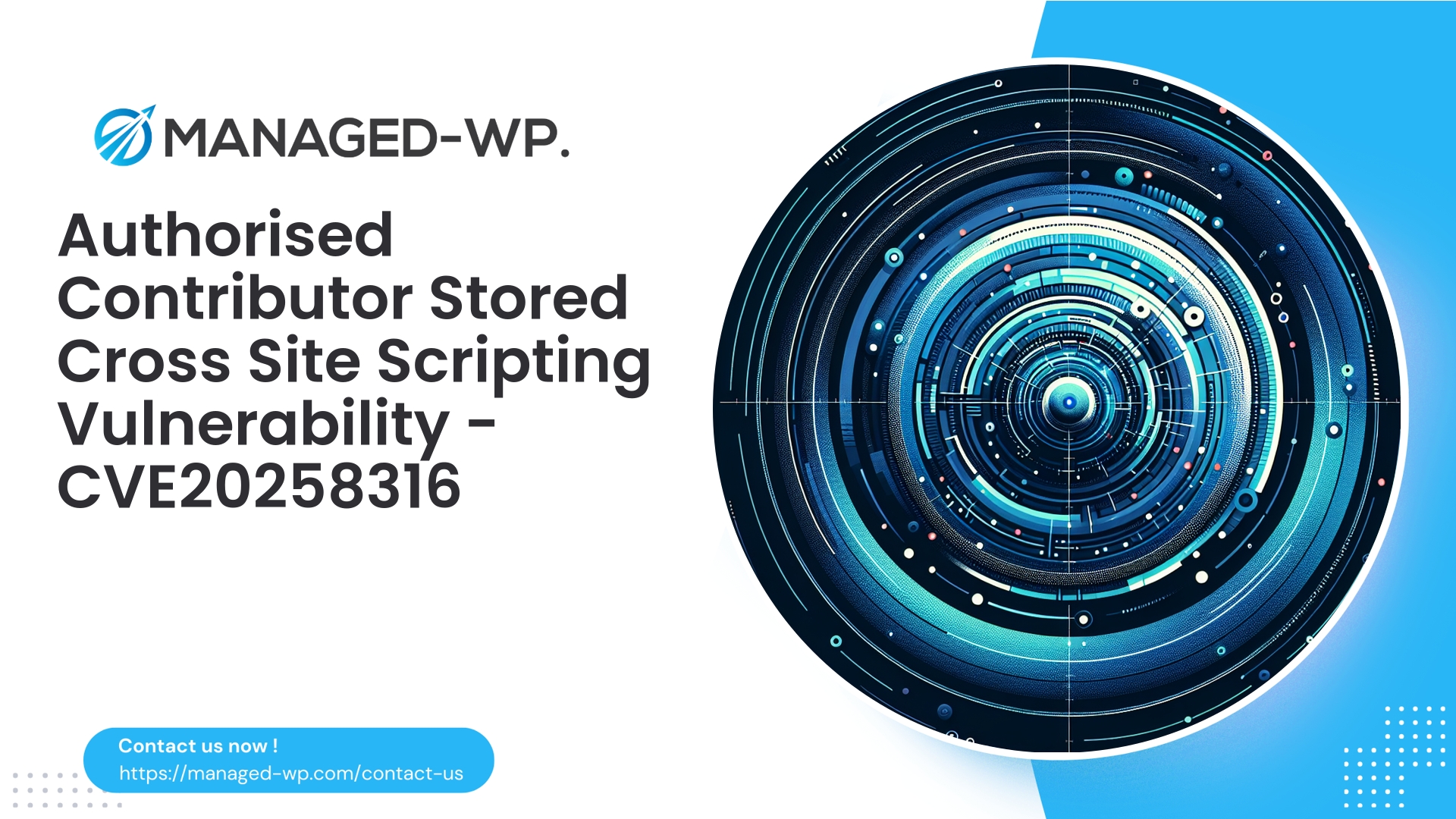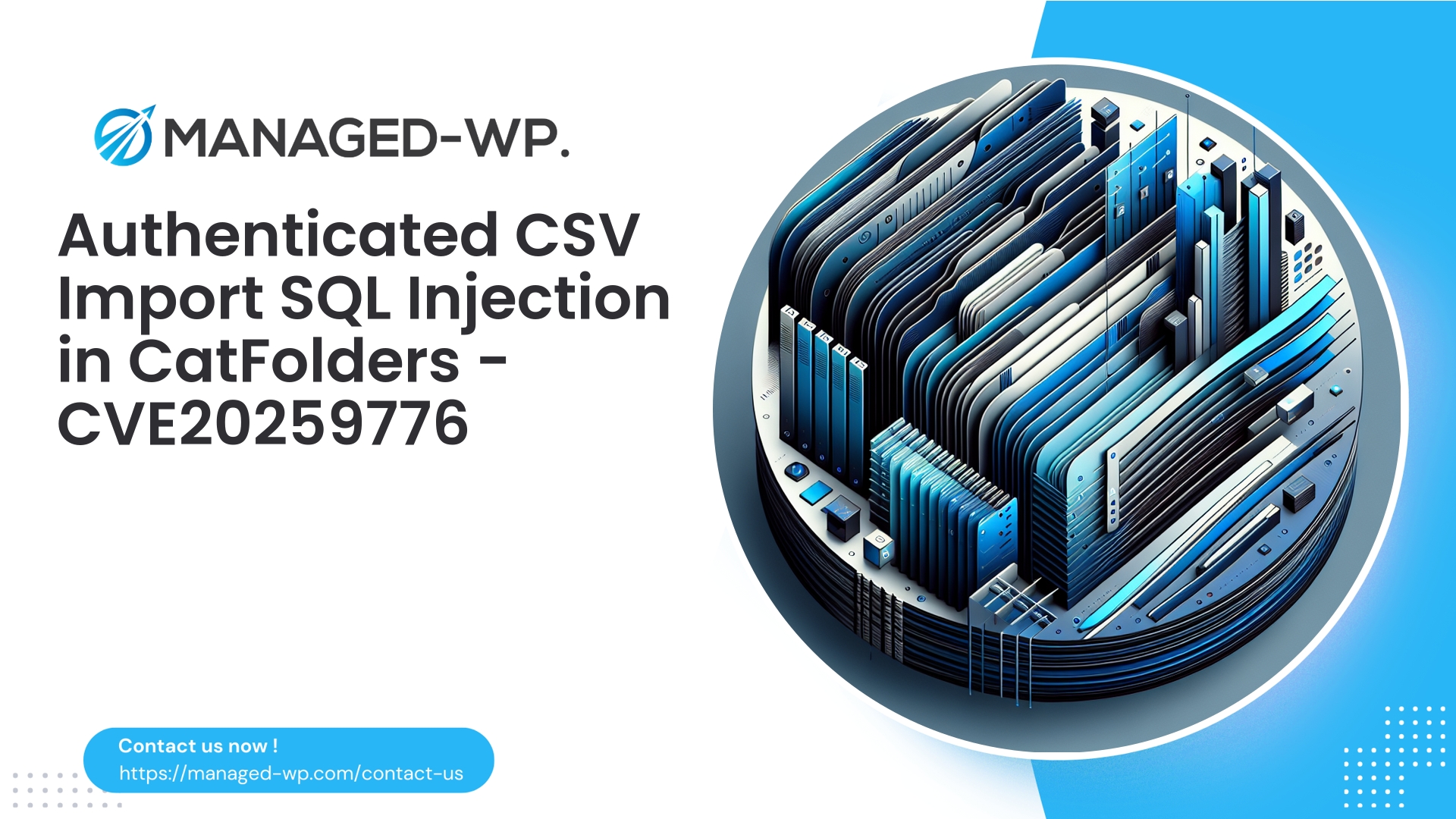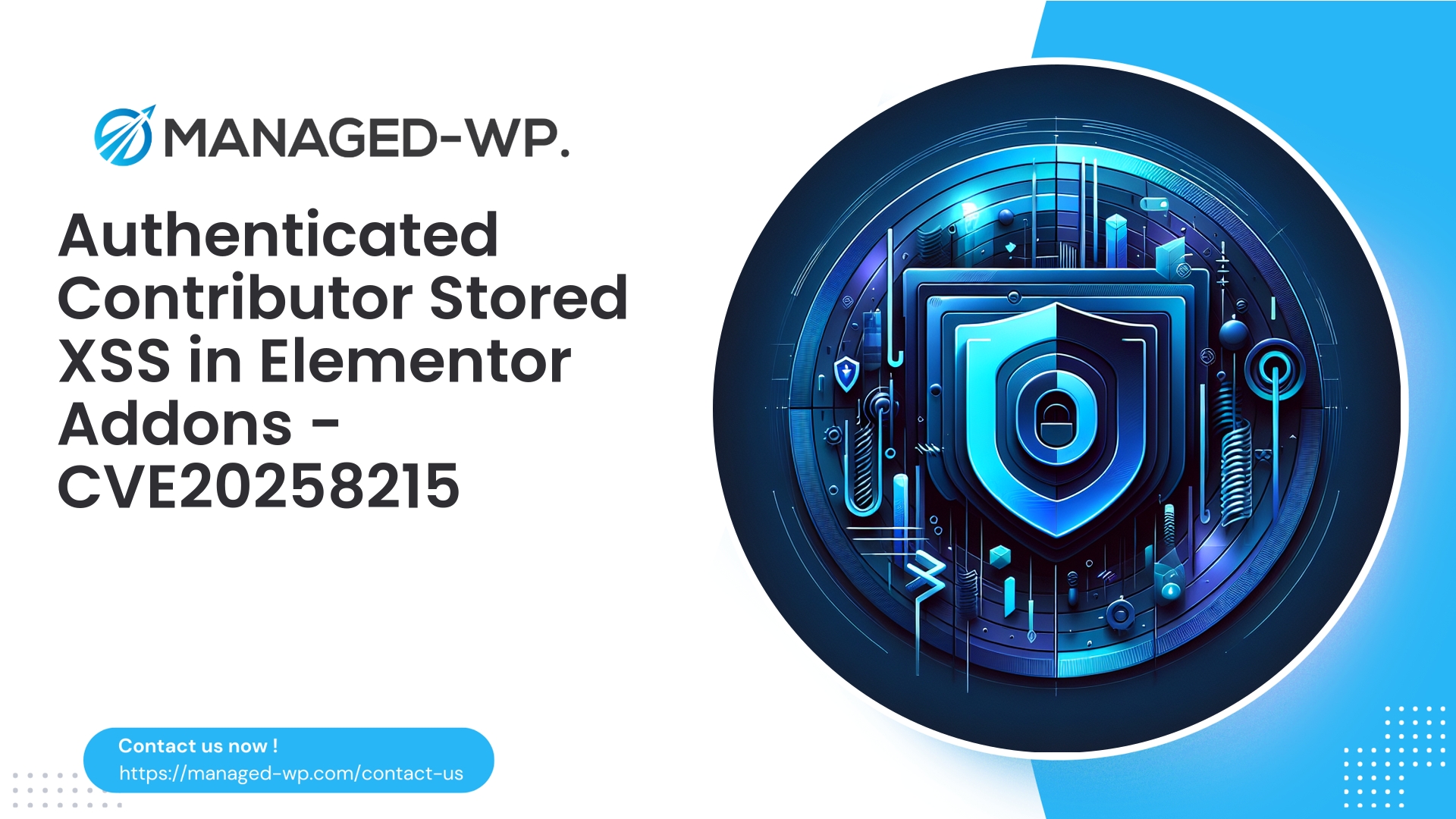| 插件名称 | Certifica WP |
|---|---|
| 漏洞类型 | 存储型跨站脚本攻击(XSS) |
| CVE编号 | CVE-2025-8316 |
| 紧急 | 低的 |
| CVE 发布日期 | 2025-09-11 |
| 源网址 | CVE-2025-8316 |
Certifica WP (<= 3.1) 认证贡献者存储型 XSS 漏洞 (CVE-2025-8316):WordPress 网站所有者需立即采取措施
作者: 托管 WordPress 安全团队
日期: 2025-09-11
标签: WordPress、网络安全、XSS、Web应用程序防火墙、CVE-2025-8316、插件安全
执行摘要
Certifica WP 插件 3.1 及更低版本中发现了一个存储型跨站脚本 (XSS) 漏洞,漏洞编号为 CVE-2025-8316。此安全漏洞允许具有“贡献者”或更高权限的已认证用户向插件注入未经处理的输入。 事件 该参数随后会在未经适当清理的情况下呈现给其他用户的浏览器。该漏洞的 CVSS 评分约为 6.5,属于中等风险,表明存在一定风险——需要进行身份验证,但根据具体情况,可能导致会话劫持、权限提升或更广泛的网站入侵。
在本报告中,Managed-WP 的网络安全专家将提供全面的技术分析、实际的攻击场景、检测指南和可操作的缓解措施,包括插件供应商补丁发布之前您可以实施的紧急干预措施。
了解风险:存储型 XSS 与其他 XSS 类型的比较
跨站脚本攻击 (XSS) 漏洞允许攻击者注入恶意脚本(通常是 JavaScript),这些脚本会在其他用户的浏览器中执行。与反射型 XSS 不同,存储型 XSS 尤其危险,因为恶意载荷会永久存储在服务器端(例如数据库或设置中),并持续提供给访问者。
存储型 XSS 攻击可用于:
- 在受害者的浏览器中执行任意 JavaScript 代码。
- 窃取 cookie 或身份验证令牌(如果未得到妥善保护)。
- 代表特权用户执行未经授权的操作。
- 部署更多恶意载荷,例如重定向或恶意下载。
- 在现场建立后门或持久立足点。
由于此漏洞需要贡献者级别的访问权限——这在多作者或社区网站上通常很容易获得——因此它代表了一种被低估但严重的威胁载体。
技术概述
- 该漏洞存在于处理该漏洞的端点中。
事件范围。 - 输入内容未经充分验证或转义就被保存了。
- 存储的值在用户界面和前端页面中呈现时没有经过适当的输出清理,从而允许执行 JavaScript。
- 该漏洞利用需要贡献者级别或以上级别的认证访问权限。
我们的做法是提供足够的细节供管理员和开发人员评估和缓解,同时避免泄露漏洞利用代码。
潜在攻击场景
- 恶意贡献者提交精心构造的事件数据,其中包含跨站脚本攻击 (XSS) 载荷。当管理员或编辑访问受影响的页面时,这将触发脚本执行,从而危及他们的会话令牌或管理员权限。
- 攻击者入侵贡献者帐户,以持久化恶意脚本,影响公共访问者,从而实施网络钓鱼活动或恶意广告。
- 针对特定目标的攻击可能仅在管理员环境下激活有效载荷,以逃避检测并最大限度地造成破坏。
影响评估和优先排序
- 复杂度:低到中等(需要已认证的贡献者)
- 所需权限:贡献者(可以创建内容但不能发布)
- 风险:会话劫持、权限提升、持续篡改、通过联合内容注入供应链
- 短期优先级:中等——立即实施补丁或虚拟补丁
- 长期优先级:高——审查内容管理和用户权限分配
对于拥有多个贡献者或公开内容提交的网站而言,应将此漏洞视为重大风险。
检测与验证
- 验证插件版本
- 确认 Certifica WP 是否已安装,以及当前版本是否为 3.1 或更早版本。
- 使用 WordPress 管理后台的插件界面或运行以下命令:
wp plugin list --format=table
- 识别可疑内容
- 搜索
事件在文章中使用 SQL 查询来定义参数或脚本标签、元值或选项:SELECT ID, post_title, post_date FROM wp_posts WHERE post_content LIKE '%
- 发现异常的 iframe、事件处理程序或嵌入式数据 URI。
- 搜索
- 评论贡献者活动
- 审核投稿人帐户中最近的帖子、草稿和修改稿。
- 检查可疑的发布行为或登录尝试。
- 检查日志和WAF警报
- 查找包含以下内容的请求
事件参数值可疑。 - 检查安全插件或WAF日志中是否存在与此参数相关的阻止。
- 查找包含以下内容的请求
- 浏览器层面的症状
- 意外重定向、弹出窗口或会话过期可能表明存在恶意攻击行为。
如果出现可疑迹象,请将您的网站视为已被入侵,并立即进行修复。
网站管理员需立即采取的行动(24小时内)
- 限制接触
- 如果并非关键任务,请暂时禁用 Certifica WP 插件。
- 如果禁用不可行,则限制贡献者访问权限并限制此类帐户的登录权限。
- 加强用户访问
- 审核并移除可疑的贡献者账户。
- 对所有特权用户轮换密码,并强制执行多因素身份验证等强身份验证方法。
- 应用 Web 应用程序防火墙或虚拟补丁
- 部署有针对性的WAF规则,阻止其中的风险模式
事件范围。 - 启用托管 WAF 功能,动态拦截恶意载荷。
- 部署有针对性的WAF规则,阻止其中的风险模式
- 扫描恶意软件和后门
- 对数据库和文件系统进行彻底的恶意软件扫描。
- 如果检测到安全漏洞,请隔离该站点并启动事件响应程序。
- 备份您的网站
- 在进行修复之前,请创建一个全新的、安全的异地备份。
开发人员级别的缓解措施(1-7 天内)
- 输入验证和清理
- 强制执行严格的服务器端验证
事件输入。 - 使用 WordPress 清理功能,例如
sanitize_text_field()或者wp_kses_post()视情况而定。
- 强制执行严格的服务器端验证
- 能力强制执行
- 使用以下方式验证用户权限
当前用户可以()在处理输入之前。 - 使用随机数来防止 CSRF 攻击。
- 使用以下方式验证用户权限
- 输出转义
- 使用诸如以下函数对所有输出进行上下文转义:
esc_html(),esc_attr(), 或者esc_js().
- 使用诸如以下函数对所有输出进行上下文转义:
- 限制不必要的渲染
- 避免将用户设置为不受信任。
事件不受信任的用户可以看到的字段。
- 避免将用户设置为不受信任。
如果您不是插件作者,请立即通知他们,并在官方修复程序发布之前暂时依赖虚拟补丁解决方案。
代码修复最佳实践建议
- 对输入内容进行清理:
$safe_evento = sanitize_text_field( $_POST['evento'] ?? '' );对于多行文本,请考虑
sanitize_textarea_field(). - 强制执行随机数和能力检查:
if ( ! isset( $_POST['nonce'] ) || ! wp_verify_nonce( $_POST['nonce'], 'evento_action' ) ) { return; } if ( ! current_user_can( 'edit_posts' ) ) { wp_die( '权限不足' ); } - 转义输出:
回声 esc_html( $safe_evento ); - 如有必要,请将 HTML 添加到白名单:
$allowed_tags = wp_kses_allowed_html( 'post' ); $clean_html = wp_kses( $user_input_html, $allowed_tags ); - 对用户提交内容的端点实施日志记录和速率限制。
开发人员应集成自动化安全测试来验证这些缓解措施。
应对疑似泄露事件
- 假设存在受影响的账户或后门。
- 调查期间,将网站置于维护模式或使其离线。
- 重置管理员、FTP 和主机帐户的密码。
- 撤销并更新所有 API 密钥、令牌和凭证。
- 审计
wp_users,wp_options以及未经授权的更改或注入脚本的内容表。 - 尽可能从经过验证的干净备份中恢复。
- 如果内部清理能力不足,请聘请专业的事故响应服务公司。
Managed-WP 如何保护您的网站
Managed-WP 提供全面的 WordPress 安全托管服务,采用多层防御机制,可降低 CVE-2025-8316 等漏洞带来的风险:
- 实时虚拟补丁: 部署针对特定目标的精确 WAF 规则
事件此参数用于阻止漏洞利用尝试,直到应用官方厂商补丁为止。 - 高级有效载荷检查: 使用启发式检测来识别和阻止用户输入中的可疑脚本和事件处理程序。
- 持续监控和警报: 通知网站所有者已阻止的攻击尝试,并提供详细的上下文信息以便快速响应。
- 自动恶意软件扫描和清理: 检测存储的 XSS 指标和相关后门,以便立即进行修复。
- 安全加固建议: 提供有关强制执行输入验证、输出转义和能力检查的实用指导。
我们的托管服务优先处理虚拟补丁,减少了立即停用插件的需要,并在补丁部署期间实现无缝保护。
推荐的虚拟补丁策略
- 拦截包含以下内容的请求
事件插件特定端点的参数。 - 阻止具有可疑模式的请求,例如
<script,javascript:或内联事件(错误=,点击=). - 允许无害输入,同时记录所有被阻止的输入。
- 对于模棱两可的情况,可以选择实施 CAPTCHA 或挑战页面,以减少误报。
务必在测试环境中彻底测试虚拟补丁,以避免干扰正常功能。
用于检测可疑条目的示例查询
安全团队可以使用这些示例 SQL 查询来检测数据库中潜在的恶意载荷。在执行查询或批量修改之前,务必先进行备份。
- 包含脚本标签的帖子:
SELECT ID, post_title, post_date FROM wp_posts WHERE post_content LIKE '%
- 包含 Postmeta 的
事件密钥或可疑值:SELECT post_id, meta_value FROM wp_postmeta WHERE meta_key LIKE '%evento%' OR meta_value LIKE '%evento%';
- 启用自动加载且包含脚本标签的选项:
SELECT option_name FROM wp_options WHERE option_value LIKE '%
全面加固检查清单
- 为所有管理员和编辑启用多因素身份验证(MFA)。
- 限制贡献者权限,包括限制不必要的文件上传。
- 所有用户角色均需遵循最小权限原则。
- 通过设置 HttpOnly、Secure 和 SameSite 标志来强化 cookie。
- 实施内容安全策略 (CSP) 以限制内联脚本执行。
- 保持 WordPress 核心、主题和插件更新;在测试环境中进行测试。
- 定期进行异地备份,并采用经过测试的恢复协议。
- 持续监控日志,并对可疑的管理员或内容活动发出警报。
与插件作者互动并报告漏洞
- 如果存在公开漏洞披露计划,请报告调查结果,包括 CVE 详细信息和脱敏后的证据。
- 提供清晰的复现步骤,无需提供漏洞利用代码,以便于补丁开发。
- 鼓励及时更新插件,使其包含输入清理和正确的输出转义功能。
事件.
如果供应商响应延迟,请优先使用虚拟补丁保护网站,或考虑暂时移除插件。
团队内部沟通示例
主题: 严重安全警报:Certifica WP 插件存在存储型 XSS 漏洞 (CVE-2025-8316)
信息:
- Certifica WP 插件(版本≤3.1)包含一个存储型 XSS 漏洞,可通过以下方式利用:
事件由具有贡献者级别访问权限的用户设置参数。 - 我们已立即采取缓解措施:禁用插件(或应用 WAF 规则)、创建备份并审查贡献者权限。
- 下一步包括轮换密码、运行全面的恶意软件扫描、对数据库进行可疑脚本审计,以及为可能从备份中恢复做好准备。
- 联系 Managed-WP 支持团队,获取虚拟补丁协助和增强监控服务。
厂商补丁发布后
- 在正式发布前,先在测试环境中进行更新。
- 审查修复程序是否包含适当的安全控制措施:清理、转义、随机数验证和功能检查
事件. - 只有在验证成功后才能部署到生产环境。
- 移除与官方补丁冲突的临时 WAF 规则,同时保持适当的保护措施。
当前对 WordPress 网站所有者的建议
- 如果已安装并运行 Certifica WP 版本 3.1 或更早版本,请将您的环境视为易受攻击的环境,并立即采取缓解措施。
- 通过加强审批流程和限制预览权限,改进涉及投稿人或外部作者的内容提交工作流程。
- 立即扫描您的网站和数据库,检查是否存在脚本注入。
- 在等待官方插件修复期间,采用托管虚拟补丁解决方案来维持业务连续性。
立即保护您的网站 — Managed-WP 的免费安全计划
标题: 立即使用 Managed-WP 免费安全计划保护您的 WordPress 网站
Managed-WP 提供免费安全方案,旨在快速、轻松地部署业界领先的防护措施。如果您担心 Certifica WP 的存储型 XSS 等漏洞,我们的免费方案可提供必要的防御措施:托管式 WAF、无限带宽、自动化恶意软件扫描以及针对 OWASP Top 10 风险的缓解措施——从一开始就阻止攻击尝试。
立即注册,即可享受即时虚拟补丁和持续监控: https://managed-wp.com/free-security-plan
对于需要自动清除恶意软件、IP 黑名单、详细分析或高级虚拟补丁的团队,Managed-WP 提供标准版和专业版计划,以满足各种组织需求。
Managed-WP 安全专家的最后总结
不应低估可通过贡献者级别访问权限利用的漏洞。鉴于这些漏洞在多作者平台上普遍存在,它们会为持久化攻击、权限提升和运营中断打开方便之门。
有效的防御需要可靠的安全编码实践、严格的访问控制、警惕的监控以及多层保护,例如托管式 Web 应用程序防火墙,可在开发永久性修复程序的同时提供快速的虚拟补丁。
如果您在实施虚拟补丁、威胁检测或事件响应计划方面需要帮助,Managed-WP 的专业安全团队随时准备为您的 WordPress 环境提供支持。
从漏洞披露到被实际利用的时间通常很短。立即采取行动保护您的网站,并始终对处理用户输入的插件进行严格审查,直到确认其安全为止。
— Managed-WP 安全团队



















